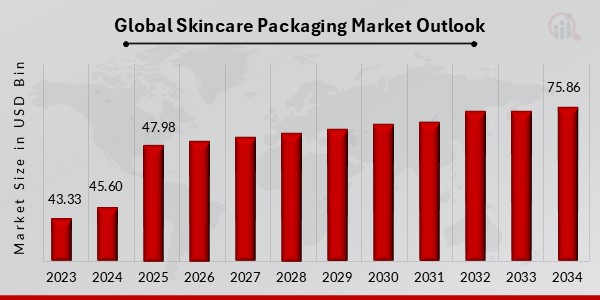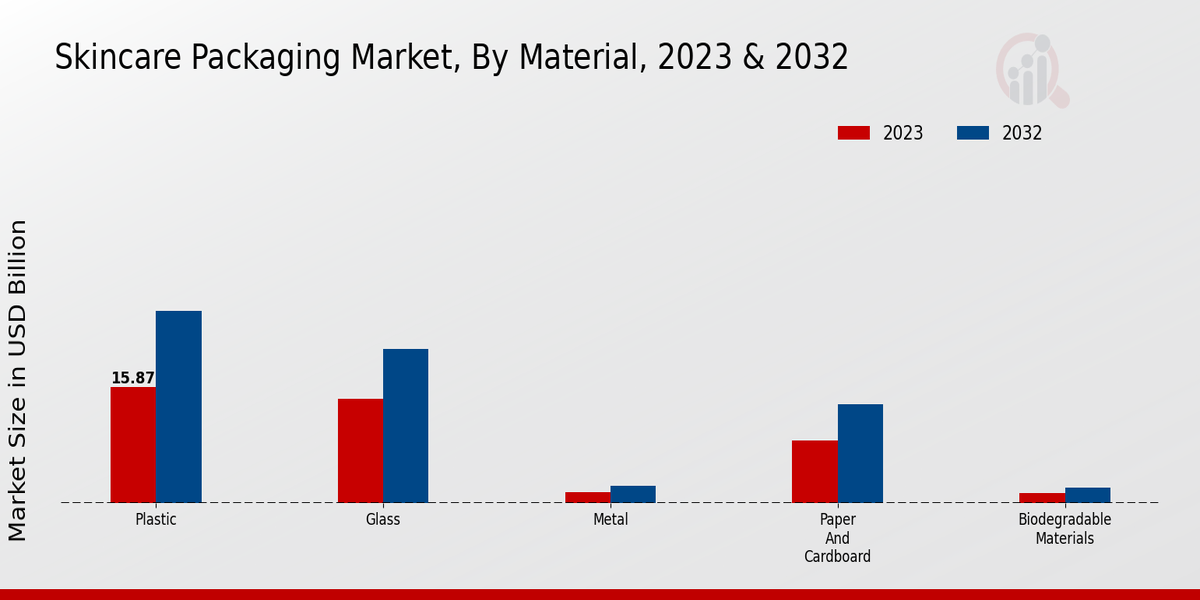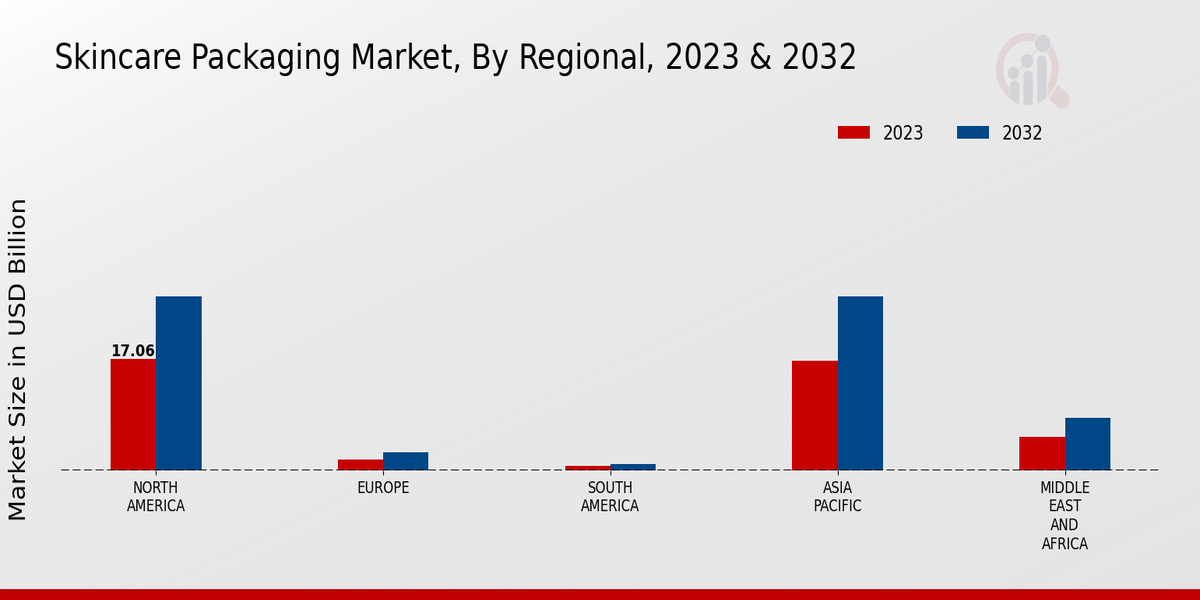Global Skincare Packaging Market Overview
The Skincare Packaging Market Size was estimated at 45.60 (USD Billion) in 2024. The Skincare Packaging Industry is expected to grow from 47.98 (USD Billion) in 2025 to 75.86 (USD Billion) by 2034. The Skincare Packaging Market CAGR (growth rate) is expected to be around 5.22% during the forecast period (2025 - 2034).
 Source: Primary Research, Secondary Research, Market Research Future Database and Analyst Review
Source: Primary Research, Secondary Research, Market Research Future Database and Analyst Review
Key Skincare Packaging Market Trends Highlighted
The growth of the skincare packaging market is driven by the increasing demand for premium and personalized skincare products, the rise of e-commerce, and growing awareness of eco-friendly solutions. The demand for sustainable packaging, such as biodegradable or recyclable options, is also a major factor driving market growth.
The increasing popularity of travel-sized and single-dose packaging offers significant growth opportunities for manufacturers. Additionally, the emergence of smart packaging technologies, which provide consumers with interactive experiences and product information, presents opportunities for innovation.Recent trends in the skincare packaging market include the adoption of minimal and aesthetic designs, the use of high-quality materials and finishes, and the incorporation of customizable features. The integration of digital technologies, such as augmented reality, is also gaining traction, allowing consumers to interact with product packaging and access additional information.
Skincare Packaging Market Drivers
Rising Demand for Sustainable Packaging
Consumers are becoming increasingly aware of the environmental impact of packaging, and they are demanding more sustainable options. This is driving the growth of the skincare packaging market, as manufacturers are looking for ways to reduce their environmental footprint. Some of the key trends in sustainable skincare packaging include the use of recycled materials, biodegradable materials, and refillable containers. The Skincare Packaging Market Industry is expected to witness a surge in demand in the upcoming years owing to the escalating requirement for eco-friendly packaging solutions across the globe.
Growth of the E-commerce Industry
The growth of the e-commerce industry is another major driver of the skincare packaging market. As more and more consumers are shopping for skincare products online, they are demanding more convenient and protective packaging. This is leading to the development of new packaging solutions that are designed to withstand the rigors of shipping. The Skincare Packaging Market Industry is anticipated to garner noteworthy traction in the years to come on account of the escalating adoption of online shopping platforms worldwide.
Increasing Demand for Premium Skincare Products
The demand for premium skincare products is also driving the growth of the skincare packaging market. As consumers are willing to spend more on high-quality skincare products, they are also demanding more luxurious packaging. This is leading to the development of new packaging solutions that are designed to enhance the perceived value of the product. The Skincare Packaging Market Industry is projected to gain significant momentum in the years ahead as a result of the growing preference for premium skincare solutions across the globe.
Skincare Packaging Market Segment Insights
Skincare Packaging Market Material Insights
The Skincare Packaging Market revenue was valued at USD 36.91 billion in 2023 and is projected to reach USD 53.89 billion by 2032, exhibiting a CAGR of 4.6% during the forecast period (2024-2032). The market is segmented based on materials into plastic, glass, metal, paper and cardboard, and biodegradable materials. Plastic is the dominant material type in the Skincare Packaging Market, accounting for a revenue share of over 50% in 2023. Plastic offers numerous advantages, such as lightweight, durability, cost-effectiveness, and versatility in design.Glass is another widely used material, particularly for high-end skincare products.
Glass packaging provides a premium look and feel, preserves product integrity, and is recyclable. Metal is gaining popularity due to its durability, recyclability, and ability to protect products from external factors. Paper and cardboard are eco-friendly and sustainable options, but they may not be suitable for all skincare products. Biodegradable materials are emerging as a promising alternative to traditional materials, offering environmental sustainability and biodegradability.The growing demand for sustainable packaging solutions is driving the growth of biodegradable materials in the Skincare Packaging Market.
The choice of material for skincare packaging depends on various factors, including product type, brand image, target audience, and sustainability considerations. Premium skincare brands often opt for glass or metal packaging to convey luxury and quality. Mass-market brands prefer plastic due to its cost-effectiveness and wide availability. Eco-conscious consumers are increasingly demanding biodegradable or sustainable packaging options.The market is expected to witness significant growth in the coming years due to the rising demand for skincare products, increasing consumer awareness about sustainability, and advancements in packaging technology. Innovations in sustainable packaging materials and designs are likely to drive market growth further.

Source: Primary Research, Secondary Research, Market Research Future Database and Analyst Review
Skincare Packaging Market Packaging Type Insights
The Skincare Packaging Market is segmented based on Packaging Type into Bottles, Jars, Tubes, Sachets, and Airless Dispensers. Among these, Bottles held the largest market share of around 42.5% in 2023 and are projected to maintain their dominance throughout the forecast period. The increasing demand for skincare products in convenient and portable packaging options is driving the growth of the Bottles segment. Tubes are another popular packaging type, with a market share of approximately 28.1% in 2023.
They are preferred for products that require precise application, such as eye creams and serums.Jars, with a market share of 16.7% in 2023, are ideal for products that have a thicker consistency, such as creams and masks. Sachets and Airless Dispensers are also gaining popularity due to their convenience and ability to preserve the product's freshness.
Skincare Packaging Market End-Use Application Insights
The end-use application segment in the Skincare Packaging Market is diverse, catering to various skincare product categories. Cleansers and toners, moisturizers and lotions, serums and treatments, masks and exfoliators, and sunscreens are the prominent segments of this market. Each segment presents distinct packaging requirements based on the product's properties and intended use. For instance, cleansers and toners often come in pump bottles or tubes to facilitate easy dispensing, while moisturizers and lotions prefer jars or tubes that preserve their thicker consistency.Serums and treatments, known for their concentrated formulas, are typically packaged in dropper bottles for precise application.
Masks and exfoliators, on the other hand, may come in single-use sachets or jars, depending on the product's form and usage. Sunscreens, with their focus on protection and longevity, are commonly packaged in bottles or tubes that provide UV resistance and ensure product stability. The Skincare Packaging Market revenue for the end-use application segment is projected to reach $X billion by 2024, driven by the increasing demand for skin care products and the growing awareness of packaging's role in product efficacy and consumer experience.
Skincare Packaging Market Decoration Techniques Insights
The decoration techniques segment of the Skincare Packaging Market is expected to grow significantly in the coming years. In 2023, the market for decoration techniques was valued at $X billion and is projected to reach $Y billion by 2028, exhibiting a CAGR of X%. Printing is the most widely used decoration technique in the skincare packaging industry. It allows for high-quality, detailed designs and can be used on a variety of materials.
Labeling is another popular technique, particularly for products that require a lot of information to be conveyed.Hot stamping, embossing, and foiling are also commonly used to create a luxurious and sophisticated look. The choice of decoration technique depends on a number of factors, including the type of product, the desired aesthetic, and the budget. Printing is a relatively affordable option, while hot stamping and foiling can be more expensive. However, they can also create a more upscale look. Overall, the decoration techniques segment of the Skincare Packaging Market is expected to continue to grow in the coming years.
As consumers become more sophisticated and demand more premium products, they are likely to opt for skincare packaging with high-quality decoration
Skincare Packaging Market Regional Insights
North America, Europe, APAC, South America, and MEA are the key regional segments of the Skincare Packaging Market. North America held the largest market share in 2023 and is expected to continue its dominance during the forecast period, owing to the presence of a large number of cosmetic and personal care companies in the region. Europe is another major market for Skincare Packaging and is expected to grow at a steady pace during the forecast period.
APAC is the fastest-growing region in the Skincare Packaging Market, driven by the increasing demand for skincare products in emerging economies such as China and India.South America and MEA are relatively smaller markets for Skincare Packaging but are expected to witness significant growth in the coming years.

Source: Primary Research, Secondary Research, Market Research Future Database and Analyst Review
Skincare Packaging Market Key Players And Competitive Insights
Major players in the Skincare Packaging Market industry are continuously innovating and developing new products to meet the evolving needs of consumers. Leading Skincare Packaging Market players are focusing on sustainability, personalization, and convenience to enhance their product offerings. The Skincare Packaging Market industry is characterized by intense competition, with manufacturers striving to differentiate their products and gain market share. This competitive landscape is driven by factors such as technological advancements, changing consumer preferences, and the emergence of new market entrants.
Skincare Packaging Market development is expected to be influenced by growing demand for eco-friendly packaging solutions, increasing awareness about the importance of skincare, and rising disposable income in developing countries.One of the key competitors in the Skincare Packaging Market is Amcor. The company offers a wide range of skincare packaging solutions, including tubes, bottles, and jars. Amcor has a strong global presence and is well-known for its innovative packaging designs. The company is committed to sustainability and has implemented various initiatives to reduce its environmental impact.
Amcor's customer-centric approach and focus on research and development have contributed to its success in the Skincare Packaging Market.Another major competitor in the Skincare Packaging Market is Berry Global. The company provides a comprehensive portfolio of skincare packaging solutions, including plastic bottles, tubes, and closures. Berry Global has a strong focus on innovation and is constantly developing new and improved packaging solutions. The company has a global presence and caters to a diverse customer base. Berry Global's commitment to quality and customer satisfaction has made it a preferred choice for skincare brands around the world.
The company's strong financial performance and sustainability initiatives further contribute to its competitive advantage in the Skincare Packaging Market.
Key Companies in the Skincare Packaging Market Include
Skincare Packaging Market Industry Developments
The Skincare Packaging Market is projected to grow from USD 41.18 billion in 2023 to USD 65.1 billion by 2032, at a CAGR of 5.22% during the forecast period. Rising consumer awareness about the importance of skincare and increasing disposable income are major factors driving the growth of the market. Additionally, the growing popularity of e-commerce platforms and the expansion of the cosmetics industry are further fueling the demand for skincare packaging. Key players in the market include Amcor, AptarGroup, Berry Global, and Silgan Dispensing.
Recent developments in the market include the launch of sustainable packaging solutions and the adoption of advanced printing technologies. The market is expected to witness significant growth in the Asia-Pacific region, driven by the increasing demand for skincare products in countries such as China and India.
Skincare Packaging Market Segmentation Insights
-
Skincare Packaging Market Material Outlook
-
Skincare Packaging Market Packaging Type Outlook
-
Skincare Packaging Market End-Use Application Outlook
-
Skincare Packaging Market Decoration Techniques Outlook
-
Skincare Packaging Market Regional Outlook
| Report Attribute/Metric |
Details |
| Market Size 2024 |
45.60 (USD Billion) |
| Market Size 2025 |
47.98 (USD Billion) |
| Market Size 2034 |
75.86 (USD Billion) |
| Compound Annual Growth Rate (CAGR) |
5.22% (2025 - 2034) |
| Report Coverage |
Revenue Forecast, Competitive Landscape, Growth Factors, and Trends |
| Base Year |
2023 |
| Market Forecast Period |
2025 - 2034 |
| Historical Data |
2019 - 2022 |
| Market Forecast Units |
USD Billion |
| Key Companies Profiled |
MeadWestvaco, Ball, Berry Global, Mondi, OwensIllinois, Gerresheimer, Amcor, Crown Holdings, WestRock, Sonoco Products, Stora Enso, CCL Industries, Aptar, Huhtamaki, DS Smith |
| Segments Covered |
Material, Packaging Type, End-Use Application, Decoration Techniques, Regional |
| Key Market Opportunities |
Sustainable Packaging Solutions Customization and Personalization ECommerce Growth Innovations in Dispensing Systems Digital Connectivity |
| Key Market Dynamics |
Sustainability Focus EcoFriendly Materials Customization and Personalization Premiumization Technological Advancements |
| Countries Covered |
North America, Europe, APAC, South America, MEA |
Frequently Asked Questions (FAQ):
Skincare Packaging Market Size is Anticipated to Reach at a USD 75.86 Billion 2034 with CAGR 5.2 % by 2025-2034
Asia-Pacific is expected to dominate the Skincare Packaging Market, accounting for the largest market share of 40.5% in 2023. The region's growing population, rising disposable income, and increasing awareness of skincare products are key factors driving the market growth.
The growth of the Skincare Packaging Market is primarily driven by the increasing demand for skincare products, rising consumer awareness of sustainable packaging solutions, and technological advancements in packaging design and materials.
Skincare Packaging is primarily used for packaging various skincare products such as cleansers, moisturizers, serums, masks, and sunscreens. It plays a crucial role in protecting, preserving, and dispensing these products effectively.
Key competitors in the Skincare Packaging Market include Amcor, AptarGroup, Berry Global, DS Smith, Huhtamaki, and Silgan Holdings. These companies offer a wide range of skincare packaging solutions, including bottles, jars, tubes, and pumps.
Emerging trends in the Skincare Packaging Market include the adoption of sustainable and eco-friendly packaging materials, the use of advanced printing and labeling technologies, and the integration of smart packaging solutions.
Challenges faced by the Skincare Packaging Market include fluctuating raw material costs, stringent environmental regulations, and intense competition from alternative packaging materials.
The Skincare Packaging Market is projected to register a CAGR of 5.8% from 2025 to 2034, reaching a market size of USD 75.86 billion by 2034.
Key factors influencing the demand for Skincare Packaging include rising consumer spending on skincare products, growing awareness of skincare routines, and increasing adoption of online shopping for skincare products.
The Skincare Packaging Market is segmented based on material type, product type, application, and region. Material types include plastic, glass, metal, and paper. Product types include bottles, jars, tubes, and pumps. Applications include cleansers, moisturizers, serums, masks, and sunscreens. Regions include North America, Europe, Asia-Pacific, Latin America, and the Middle East & Africa.






 Source: Primary Research, Secondary Research, Market Research Future Database and Analyst Review
Source: Primary Research, Secondary Research, Market Research Future Database and Analyst Review










